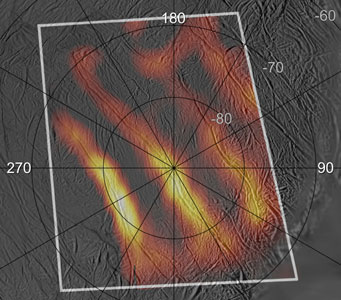Everyone has a different definition of beauty. And like a Rorschach inkblot test, I think someone's definition of beautiful speaks volumes about that person. For me, most of my "beautiful" images simply expose just how big a geek I really am.

Late last month Cassini recorded these maps of Enceladus's south pole when it was between 14,000 and 32,000 km away. The color overlay atop the Tiger Stripe fractures shows the heat coming from the deep cuts on the surface. The warmest spots are -135°F whereas the rest of the surface is only -330°F.
NASA/JPL/GSFC/SwRI/SSI
I'll prove it to you. Let's focus on last week's press conference about Cassini's Enceladus flyby. Perhaps you've seen the stunning images of the plumes of gas and dust spewing off the surface of the icy Saturnian moon. Many might call that beautiful — and I would tend to agree. However, in my opinion, the scene on the right is more beautiful still. Let me explain why:
This is a view of Enceladus's south pole and the now famous Tiger Stripes. These long fractures are the source of the geysers, and were known to be hotter than any other place on the satellite. Notice I said hotter, not warmer. The latest measurements show peak temperatures at around -135°F, whereas the rest of the moon's surface hovers around -330°F.
But what makes this image so "beautiful" is the color overlay. You're seeing a high-resolution temperature map taken by Cassini's Composite Infrared Spectrometer. The CIRS never gets much press, but it deserves the spotlight for this view! Sure enough, the hot spots line up perfectly with the deep cracks in Enceladus's surface. Cassini scientist John Spencer (Southwest Research Institute, Colorado) goes a step further. "The plumes tend to be coming out of the warmest points of the fractures. It's entirely possible that there is going to be liquid water not too far below the surface of these warm fractures."
In other news, the spectroscopy folks found bunches of simple organic compounds in the towering plumes themselves. Interestingly, the composition closely resembles that of a comet. That tidbit is sure to send the experts' heads spinning.
Now I absolutely hate playing the "life card," but let's put the pieces together: we have the possibility for liquid water, we have proof of organic material, and we have a clear source of energy being put into the system. I'm not saying we'll find microbes. And I know other work rules it out. But I'm just pointing out that all the necessary ingredients are there.
And discovery like that would be beautiful indeed!
 5
5
Comments
Eduardo Ojero
April 2, 2008 at 2:02 pm
Amazing what we are getting from this spacecraft ! Who could imagine some weeks ago the Enceladus was keeping all these surprises !!
Thanks David for giving us the oportunity to enjoy it.
Eduardo (Madrid, Spain)
You must be logged in to post a comment.
T.Droppa
April 3, 2008 at 2:10 pm
There seems to be a huge, almost obsessive interest in finding life on other planets or moons. What is driving this intense obsession? Is there some philosophical root that feeds this or what? It seems to eclipse all other interests. It seems to me that there are lots of things to take an interest in besides proving life might exist. Aren't there?
Curious.
You must be logged in to post a comment.
J Mahony
April 5, 2008 at 4:13 am
I agree the life card is played so freely that we risk being accused of crying wolf, but your sentence near the end, that in this case other work "rules it [life] out", is wrong, or at least misleading. That linked article is about an alternate possibility that the geysers may not require liquid water. And if there's no liquid water then there's virtually no chance for life. But the article only presents an alternate possibility, not conclusive proof that the proposed situation _must_ be the case. So there's still a decent chance of liquid water, and therefore some chance (how _much_ chance is still an open question) for life.
When I re-read your paragraph I realize you probably meant "rules it out if that theory is correct", but it doesn't read that way at first.
You must be logged in to post a comment.
Tomasz Kokowski
April 5, 2008 at 4:09 pm
Interesting picture. It suggests a sub-crust/sub-ice heat geyser likely povered by tidal forces just like expected fenomena on Europa tidally squeezed by Jupiter. It is another one promise (not evidence yet!) for plausibility of Enceladus to harbour life. As for now we have only indirect evidence of liquid water on Enceladus yet. Is there a deep - maybe salty - ocean below Enceladus icy crust required for life to be born? Such a liquid environment and some even limited in scale deep-water heat plumes are enough for it, I guess. Just like on Earth where sulfur-based microbes live in the ocean deep inside and around volcanic heat plumes.
And finally, replaying to the question about meaning of extraterrestrial life search just remember Eleanor Arroway's sentence in Carl Sagan's "Contact".
You must be logged in to post a comment.
George Eberts
April 13, 2008 at 10:57 am
No need to be defensive or explain at length. Finding life somewhere other than Earth will be the most impactful thing science will have ever done up to that moment, triggering intense religious and social reflection. Yes "there are lots of things to take an interest in besides proving life might exist", but NOTHING as important to the human psyche.
You must be logged in to post a comment.
You must be logged in to post a comment.